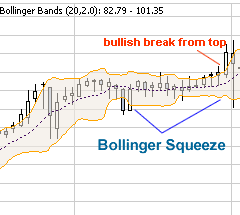What are Bollinger Bands?
Bollinger Bands is a versatile tool combining moving averages and standard deviations and is one of the most popular technical analysis tools available for traders.
There are three components to the Bollinger Band indicator:
- Moving Average: By default, a 20-period simple moving average is used.
- Upper Band: The upper band is usually 2 standard deviations (calculated from 20-periods of closing data) above the moving average.
- Lower Band: The lower band is usually 2 standard deviations below the moving average.
Significance of Bollinger Bands
- Bollinger Bands help you to evaluate a stock’s volatility over time. When plotting Bollinger Bands on a chart will see one line above and one line below the price chart of the stock. When a stock is making major price movements or is very volatile its Bollinger Bands will be farther away (expand) from the stock’s price chart. When a stock is moving steadily with minor price movements, the Bollinger Bands will be closer to (contract upon) the stock’s price chart.
- When stock prices continually touch the upper Bollinger Band, the prices are thought to be overbought; conversely, when they continually touch the lower band, prices are thought to be oversold, triggering a buy signal.
- Sharp price changes tend to occur after the bands tighten, as volatility lessens.
- When prices move outside the bands, a continuation of the current trend is implied.
- Bottoms and tops made outside the bands followed by bottoms and tops made inside the bands call for reversals in the trend.
Uses of Bollinger Bands
Bollinger Bounce
A common technical use of Bollinger Bands ® is to predict when a stock’s price will “bounce” off the top or bottom Bollinger line and then return back towards the center of the Bollinger Bands ®. Therefore, giving a bullish indicator to a stock whose price is close to or touching the bottom Bollinger Band and a bearish indicator to a stock whose price is close to or touching the top Bollinger Band.
Bollinger bands are intended to illustrate a stock’s current support and resistance levels. This means a low price the stock does well stays above (support) and a high price the stock has difficulty breaking past (resistance).
Bollinger Squeeze
Another common technique used to predict trends with Bollinger Bands ® is called the Bollinger squeeze. When the bands contract so much that they begin to appear to “squeeze” the stock’s price chart, is when the Bollinger squeeze occurs. This is usually a a pending breakout which could be bullish or bearish. Should the stock’s price begin to break above the top Bollinger Band it is a bullish sign that the stock with continue an upward trend. If the stock’s price breaks through the lower band, it is a bearish sign that the downward trend will most likely continue.
Conclusion
Bollinger Bands are a very popular indicator and the article describes many ways on how to use it. However, like most technical indicators, it should not be used alone. Bollinger Bands work best when combined with overbought/oversold oscillators. Since Bollinger Bands already take into account volatility and trend, a trader should not use indicators that duplicate this information. Instead indicators that measure volume, momentum, sentiment, open interest are better suited companions for the Bollinger Bands indicator. It is with this information in mind that the general rules presented here should not be taken by themselves as trading strategies.
Thank You !




No comments:
Post a Comment